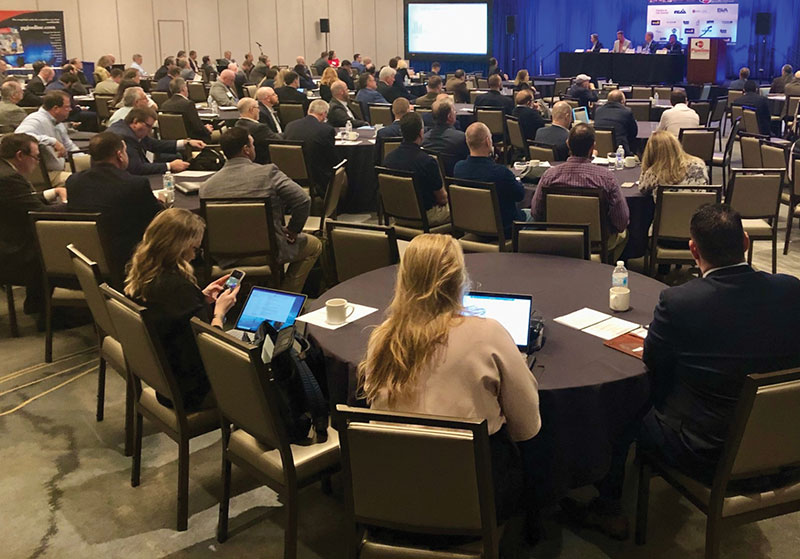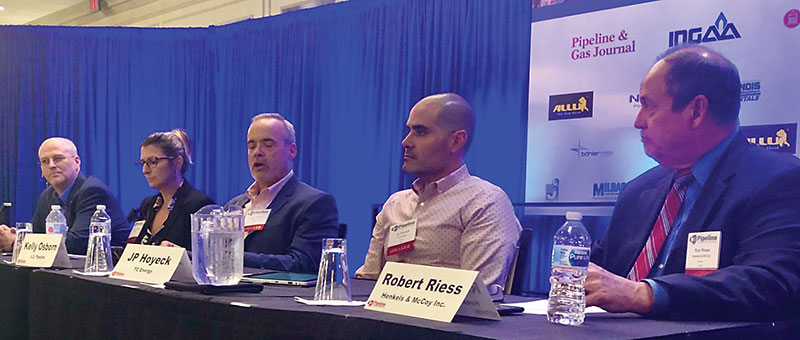April 2020, Vol. 247, No. 4
Features
Pipeline Opportunities Conference Focuses on Business, Industry Success
P&GJ Staff Report
The 16th annual Pipeline Opportunities Conference (POC) took a cautionary tone during the early spread of coronavirus, but despite the uncertainty about industry impact, experts offered guidance throughout the event on practical approaches to a myriad of known challenges and opportunities in the months ahead.
About 200 participants from all areas of the pipeline industry gathered at Houston’s Westin Galleria for the business-focused event on March 3 – roughly a month earlier than it had been held in recent years and before markets were shaken both by the spreading economic impact of the Covid 19 virus and the sector upheaval of a crude oil production and price war between Russia and Saudi Arabia.
“The timing of POC this year made it more difficult to predict the challenges our industry would face for the balance of the year, but the knowledge shared through the event made the participants better prepared to weather this challenging period,” said Pipeline & Gas Journal Editor-in-Chief Michael Reed. “In fact, it was one of few events held early enough to enable this kind of valuable information exchange before circumstances prevented such gatherings from taking place at all.”
Underscoring the point, Bruce Bullock director of Southern Methodist University’s (SMU) Maguire Energy Institute kicked off the event with a report on key factors facing the industry, describing the “unknown territory in energy” with the coronavirus while assuring the audience that a rate cut by the U.S. Federal Reserve was imminent. As if on cue, the Fed announced a half-point cut within the hour.
Bullock was one of four experts who contributed to the industry update on behalf of SMU’s Maguire Energy Institute, which joined the Interstate Natural Gas Association of America (INGAA) as co-presenter of the annual conference, along with P&GJ. Other speakers joining Bullock on the opening panel included James Coleman, associate professor of law at SMU’s Dedman School of Law; Joseph Dancy, adjunct professor at the SMU Cox School of Business and Bernard “Bud” Weinstein, associate director of the Maguire Institute.
They noted that, before OPEC’s failure to agree on production, global oil markets were already oversupplied by a half-million barrels, while reduction in economic activity was already expected to reduce demand by 1 million to 1.5 million barrels per day. The panel predicted there would be no economic growth through at least the third quarter of the year and continued downward pressure on oil prices, with potential for somewhat quicker recovery of natural gas markets.
Even before the rapid spread of the virus through Europe and into North America, they noted, 94% of Fortune 1000 supply chains had been disrupted, with shortened supply lines and an exodus of manufacturing from China that may not return. Mexico could be a beneficiary, they noted.
“We are emerging from the biggest energy and commodity boom the world has ever seen,” Coleman said, adding that the U.S. is flaring more natural gas than some countries use and emphasizing the need to get that gas to market.
The conference was held on the heels of a series of debates among Democrat candidates vying to become the party’s presidential nominee, with increasing hostility toward generic fossil fuels and claims they would ban hydraulic fracturing if elected.
Coleman emphasized the positive role of natural gas in reducing carbon, noting that air pollution is a greater threat to human health and that “natural gas is a complete solution” for addressing it. He added that, if a new Democrat president is elected, it would not be legal to ban fracking, but it could be possible to punish companies who frack and export.
Weinstein added that a ban on fracking and halt to fossil fuels would not have as meaningful an impact reducing emissions as politicians suggest. “It may kill the industry,” he said, “but it will not have much effect on climate change.”
Dancy provided an update on legal and practical issues related to drone use in the pipeline industry, noting their value in documenting spills and the condition of land prior to construction. A number of legal issues persist, however, around data confidentiality, trespass, retention and related matters, he added.
INGAA Interim President and CEO Alex Oehler presented the annual Washington Report, including an update on the industry impact of the Clean Future Act, an omnibus climate bill that would make significant changes to the authority of the Federal Energy Regulatory Commission (FERC) while redefining “public interest” for some pipeline facilities and narrowing the use of eminent domain.
Describing one of the challenges, he said that companies would have to receive every permit before using eminent domain. “The trouble is,” Oehler said, “you have to get on the land to be able to get the environmental information to get permits” making communication with landowners more important than ever.
“Lasting relationships with landowners is critically important,” he said, adding that there is an expectation that voluntary agreement for land use is possible. “INGAA recently renewed our commitment to landowners. This is a commitment grounded in respect, transparency and trust.”
A key segment of the conference was focused on the implications and practical implementation of the Pipeline and Hazardous Materials Safety Administration’s (PHMSA) so-called “Gas Mega Rule,” which Oehler described as PHMSA’s “biggest and most significant improvement to pipeline safety rules since inception.”
His presentation was followed by a Mega Rule panel discussion, which focused on explaining the different segments of the new safety rules, including class determination, expansion of assessments, material verification and MAOP (maximum allowable operating pressure) reconfirmation.
Panelists included Mark Hereth, managing director of Blacksmith Group/P-PIC; Tony Rizk, vice president of Technical Services at Gulf South Pipeline; Darral Ward, manager, Pipeline Safety, at Boardwalk Pipeline Partners; and Jeff Wiese, a former PHMSA staffer who now serves as senior vice president for Pipeline Integrity Services at TRC Solutions.
The Mega Rule, which is considered to be the most significant change to existing gas pipeline regulations since 1970, was finalized late last year by PHMSA after nearly a decade of development. Its development was initiated through an Advance Notice of Proposed Rulemaking issued in Aug. 2011, as an initial response to the fatal 2010 pipeline incident in San Bruno, Calif. Following investigations into the San Bruno incident, as well as a pipeline incident that occurred Dec. 11, 2012 in Sissonville, W.V., the National Transportation Safety Board (NTSB) issued specific recommendations to PHMSA to revise existing pipeline regulations.
The final rule was published by the Federal Register on Oct. 1, 2019, and the effective date is designated as July 1, 2020.
To address the mandate from Congress to expand to address the mandate from Congress to expand integrity management requirements beyond currently defined HCAs, PHMSA has introduced a new definition – moderate-consequence area (MCA). POC panelists explained that, starting July 1, pipeline operators are allowed 14 years under the rules to assess MCAs and Class 3 areas, prioritized by risk.
MCAs, they added, related to onshore areas within a potential impact radius with either five or more buildings intended for human occupancy. They also include pipeline crossings of such paved surfaces as interstate highways, freeways or principal arterial roadways with four or more lanes, but it will ultimately be up to operators to figure out the definition.
“This is a good thing for our industry,” said Ward, representing Boardwalk Pipeline on the conference panel. “It will provide assessments for operators in areas where we haven’t had assessments before.”
To address the mandate from Congress to expand integrity management requirements beyond HCAs, PHMSA has expanded requirements for performing pipeline assessments outside of HCAs. Specifically, these requirements will apply to pipe segments exhibiting an MAOP equal to or greater than 30% of the specified minimum yield strength (SMYS) that are present in Class 3 or 4 locations or in MCAs that also can accommodate an inline inspection (ILI) tool, and that are not already part of existing HCAs.
“This rule is not as much about miles as it is about segments,” said Hereth of Blacksmith Group/P-PIC.
To rule requires that MAOP is reconfirmed for pipelines where pressure test records are not traceable, verifiable or complete (TVC) and are in an HCA, or Class 3 or 4 location.
“The new recordkeeping procedures under the mega rule will factor into the value of midstream assets” Hereth said. “Being TVC-compliant will add more value to assets, as being non-TVC compliant could add more costs to assets.”
The conference also included a presentation on Energy Web Atlas (EWA) by Gulf Energy Information President and CEO John Royall, and EWA’s Kate Permenter, who provided examples of how EWA provides actionable project intelligence for the international energy industry, including current and proposed pipeline projects worldwide.
Mel Christopher, executive director of Gold Shovel Standard, presented an update on the program, which provides a toolset to help preserve the integrity of underground infrastructure. Gold Shovel Standard provides standardized damage prevention measurements deployment of metrics to safety for operators, excavators, locators and the public.
A panel on LNG and Renewables. moderated by Chris Williams, vice president of Pipe Operations for Cheniere Energy, discussed the growing LNG liquefaction and export infrastructure that has been rapidly expanding on the U.S. Gulf Coast, and its implications for natural gas supply and global energy trade. Panelists included Scott Culberson, vice president of Gas Supply & Trading at Cheniere; Charles McConnell, executive director of the Center for Carbon Management in Energy at the University of Houston; and Craig Meier, director of Sunland Construction.
The biggest challenges in completing new LNG projects, the panel agreed, are ensuring long-term contracts are in place to encourage investment, while the market is heading to spot pricing. It is essential to have a firm date and contract before construction can begin, they said.
Despite current depressed prices and a glut of LNG worldwide, panelists remain optimistic about the future of LNG markets.
The one-day conference concluded with a panel discussion on “Contractor and Operator Relationships that Excel,” moderated by Rob Riess, vice president and division manager for the Pipeline Division of Henkels & McCoy. Riess was joined by panelists JP Hoyeck, director of U.S. Natural Gas Projects for TC Energy; Kelly Osborn, president of U.S. Pipeline; and Brooke Justice, manager of Construction – Atlantic Gulf Onshore for Williams.







Comments